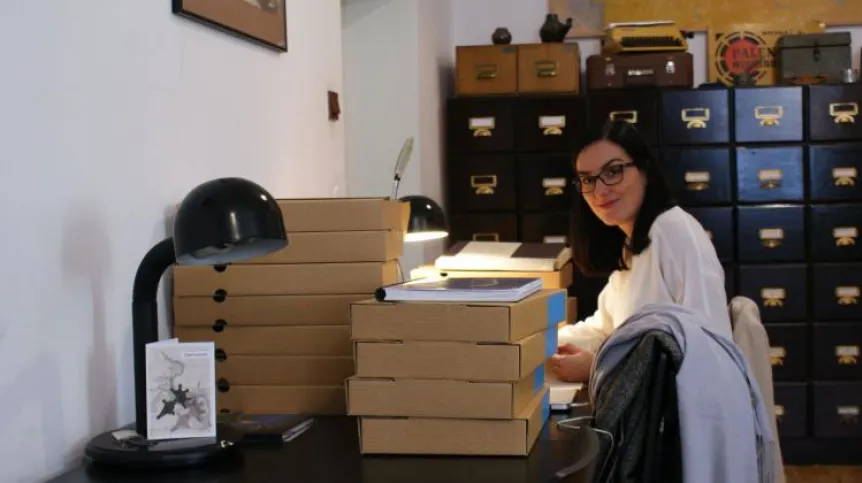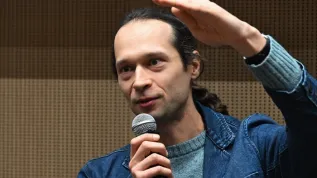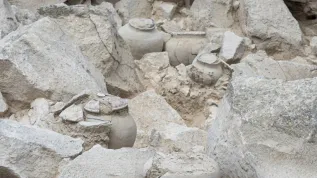
Neanderthals cared for the disabled, in ancient Egypt people of short stature were respected. In the Middle Ages, Polish burials of disabled people did not differ from other burials. Archaeologist Dr. Magdalena Matczak talks about the approach to disability in history.
“Now one-eighth of the human population is considered to be disabled. In the European Union alone, the disabled constitute approx. 14 percent of the population aged 15-64. This is a large percentage. Also in prehistoric and historical times, people with disabilities were members of the society and - if only because of the weaker development of medicine - they could have constituted a significant group,” Dr. Matczak from the University of Liverpool and Arizona State University tells PAP.
The archaeologist leads the interdisciplinary project DIS-ABLED (together with Dr. Jessika Pearson from the University of Liverpool, Professor Jane Buikstra from Arizona State University and Professor Andrzej Marek Wyrwa from the Adam Mickiewicz University in Poznań). The aim of the research project is to reconstruct the life of people with disabilities in the 14th-18th century Central Europe.
“The topic of disability is rarely addressed in archaeology. If we think of history as our heritage, we cannot fully understand this heritage if we ignore the history of such a large group of people, in this case people with disabilities,” says Dr. Matczak.
When asked about the changes in the approach to people with disabilities, she says: “In various places and throughout history, the approach to people with disabilities has fluctuated from full acceptance and care to marginalisation.”
She gives the example of an American study of Old Stone Age Neanderthals inhabiting the Shanidar Cave in present-day Iraq. “The remains of a Neanderthal with a skull trauma were found there. He was probably deaf in his right ear, had vision problems, impairment of one of the upper limbs and injuries causing abnormal gait. His condition could have made it very difficult for him to obtain food, for example, prevent him from participating in hunting. Despite that, he lived a long life with this condition, he died at the age of 40-50, hence the conclusion that he had to receive help and care from people from his community over a long period,” she says.
When it comes to ancient Egypt, ca. 2500 BC a sculpture of Seneb was created. Seneb was a dignitary at the Pharaoh's court; he was buried with his wife in Giza. This dignitary had achondroplasia, a genetic disorder whose primary feature is dwarfism. Dr. Matczak says: “Some researchers agree that in ancient Egypt there was a tolerance to both people with achondroplasia and the blind. However, there are researchers who believe that people with visual impairments could be ostracized in ancient Egypt.”
She also cites research from Bahrain on the remains of a woman from the turn of the 2nd millennium BC, who suffered from a deformation of the right humerus and had a disability of the lower limbs, due to which she required care and support. A slight wear of her teeth indicates that the woman was eating relatively soft foods. She was buried with valuable items. “This shows that at least a narrow social group, it can be assumed that it was her family, treated her well during her lifetime, and took care of a proper burial,” says Matczak.
She adds that there are also examples in history of how difficult the life of people with disabilities could be. In the 19th century US, in Oneida County, New York, people with physical or mental disabilities ended up in a shelter. The 'therapy' consisted in carrying out physical work that was so hard that in some cases it led to death from exhaustion. And the shelter earned income from that work. A disgraceful page in the 19th century history were the now completely unacceptable travelling circuses, in which people with certain disabilities were displayed to the public.
On the other hand, when it comes to Poland, there is an interesting example of a 13th century woman suffering from leprosy, buried in the cemetery in Kałdus in the Chełmno Land. Not only was leprosy contagious, it could lead to loss of sensation, vision problems and trauma, which could lead to disability.
Matczak says: “This woman lived with the lesions for a relatively long time. She would not have been able to survive without the help of the community. She was also buried in accordance with the rules of a Christian burial, and with items such as a ring and a knife. Thus, it can be indirectly concluded that her social status was relatively good and, despite her illness, she was not pushed to the margins of society.”
In previous research, Dr. Matczak, in collaboration with Professor Tomasz Kozłowski and Professor Wojciech Chudziak from the Nicolaus Copernicus University, investigated 10th-13th century burials from Kałdus in Polish Pomerania. Of the 661 skeletons the researchers studied, 33 had disability-related changes. They were more often the skeletons of disabled mature men than women, which Dr. Matczak explains was “related to the fact that statistically women more often died in early adulthood, for example due to perinatal infections. Men lived longer and worked hard physically, so their skeletons more often showed disabilities related to degenerative changes.”
Polish scientists also investigated whether skeletons showing signs of a disability could be found in the case of atypical burials (this includes graves on the north-south axis, instead of the typical east-west axis, or people buried on the side, in a foetal position) and anti-vampire burials (people buried on their stomachs or pinned down by stones).
The archaeologist recalls the example from the USA, where an anti-vampire burial from the 19th century of a person with traces of tuberculosis was found. She said: ’Blood spitting associated with tuberculosis may have been associated with vampires in the past. That is why I wanted to check whether in Pomerania in Poland certain diseases or disabilities could have caused people to be feared during their lifetime, and thus later buried in a unusual manner. This does credit to the early medieval community. Judging by the burials, sick people were not treated differently in the community.”
She adds, however, that skeletal studies do not provide conclusive evidence that a given person suffered from a disability or not. They do show that a person suffered from degenerative changes, leprosy, advanced stages of some cancers, polio, had an amputation, had a poorly healed fracture or, for example, tuberculosis of the spine. But many disabilities and diseases do not leave any trace on the skeleton. This includes, for example, mental illnesses, loss of vision or hearing, acute diseases.
Therefore, in her latest research on the perception of disability in the 14th-18th centuries, the researcher focuses on a combination of several disciplines of science: archaeology, history, physical anthropology and ethnography. “We study chronicles, lives of saints, medical writings, ethnographic texts from later times, as well as skeletons found in Poland to see which diseases people suffered from in the 14th-18th centuries,” she says.
The researcher points out that researching disability in history is difficult because the word 'disabled' was not in use until the 20th century.
“According to the latest definitions, disability is a condition, in which a person with an impairment encounters social barriers resulting from the fact that the culture, the space in which we function, is adapted to fully able-bodied people. Disability is thus defined by the relation of the non-disabled part of the population to the impaired part. So the question is how the past societies defined people with disabilities and how they adapted to their needs,” she says.
PAP - Science in Poland, Ludwika Tomala
lt/ ekr/ kap/
tr. RL













